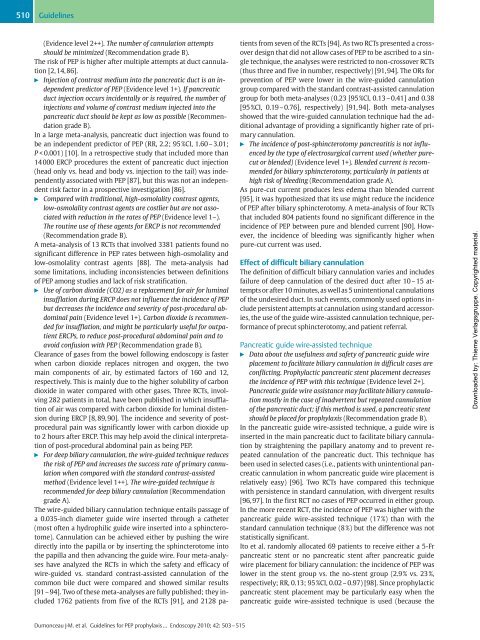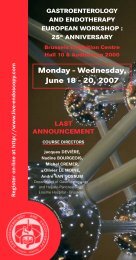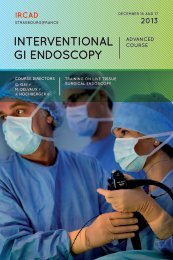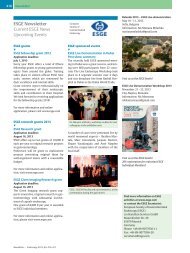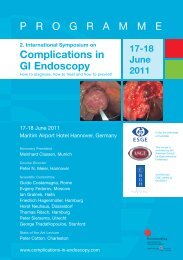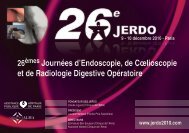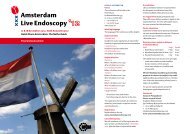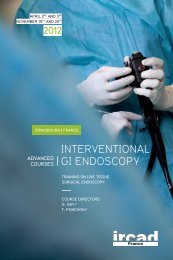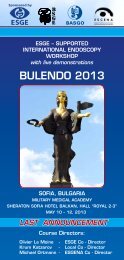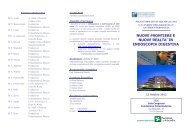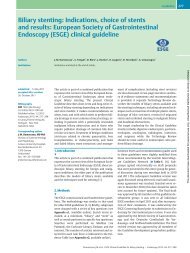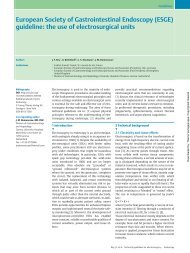(ESGE) Guideline: Prophylaxis of post-ERCP ... - ResearchGate
(ESGE) Guideline: Prophylaxis of post-ERCP ... - ResearchGate
(ESGE) Guideline: Prophylaxis of post-ERCP ... - ResearchGate
You also want an ePaper? Increase the reach of your titles
YUMPU automatically turns print PDFs into web optimized ePapers that Google loves.
510<br />
<strong>Guideline</strong>s<br />
(Evidence level 2++). The number <strong>of</strong> cannulation attempts<br />
should be minimized (Recommendation grade B).<br />
The risk <strong>of</strong> PEP is higher after multiple attempts at duct cannulation<br />
[2, 14,86].<br />
" Injection <strong>of</strong> contrast medium into the pancreatic duct is an independent<br />
predictor <strong>of</strong> PEP (Evidence level 1+). If pancreatic<br />
duct injection occurs incidentally or is required, the number <strong>of</strong><br />
injections and volume <strong>of</strong> contrast medium injected into the<br />
pancreatic duct should be kept as low as possible (Recommendation<br />
grade B).<br />
In a large meta-analysis, pancreatic duct injection was found to<br />
be an independent predictor <strong>of</strong> PEP (RR, 2.2; 95%CI, 1.60 – 3.01;<br />
P < 0.001) [10]. In a retrospective study that included more than<br />
14 000 <strong>ERCP</strong> procedures the extent <strong>of</strong> pancreatic duct injection<br />
(head only vs. head and body vs. injection to the tail) was independently<br />
associated with PEP [87], but this was not an independent<br />
risk factor in a prospective investigation [86].<br />
" Compared with traditional, high-osmolality contrast agents,<br />
low-osmolality contrast agents are costlier but are not associated<br />
with reduction in the rates <strong>of</strong> PEP (Evidence level 1–).<br />
The routine use <strong>of</strong> these agents for <strong>ERCP</strong> is not recommended<br />
(Recommendation grade B).<br />
A meta-analysis <strong>of</strong> 13 RCTs that involved 3381 patients found no<br />
significant difference in PEP rates between high-osmolality and<br />
low-osmolality contrast agents [88]. The meta-analysis had<br />
some limitations, including inconsistencies between definitions<br />
<strong>of</strong> PEP among studies and lack <strong>of</strong> risk stratification.<br />
" Use <strong>of</strong> carbon dioxide (CO2) as a replacement for air for luminal<br />
insufflation during <strong>ERCP</strong> does not influence the incidence <strong>of</strong> PEP<br />
but decreases the incidence and severity <strong>of</strong> <strong>post</strong>-procedural abdominal<br />
pain (Evidence level 1+). Carbon dioxide is recommended<br />
for insufflation, and might be particularly useful for outpatient<br />
<strong>ERCP</strong>s, to reduce <strong>post</strong>-procedural abdominal pain and to<br />
avoid confusion with PEP (Recommendation grade B).<br />
Clearance <strong>of</strong> gases from the bowel following endoscopy is faster<br />
when carbon dioxide replaces nitrogen and oxygen, the two<br />
main components <strong>of</strong> air, by estimated factors <strong>of</strong> 160 and 12,<br />
respectively. This is mainly due to the higher solubility <strong>of</strong> carbon<br />
dioxide in water compared with other gases. Three RCTs, involving<br />
282 patients in total, have been published in which insufflation<br />
<strong>of</strong> air was compared with carbon dioxide for luminal distension<br />
during <strong>ERCP</strong> [8, 89,90]. The incidence and severity <strong>of</strong> <strong>post</strong>procedural<br />
pain was significantly lower with carbon dioxide up<br />
to 2 hours after <strong>ERCP</strong>. This may help avoid the clinical interpretation<br />
<strong>of</strong> <strong>post</strong>-procedural abdominal pain as being PEP.<br />
" For deep biliary cannulation, the wire-guided technique reduces<br />
the risk <strong>of</strong> PEP and increases the success rate <strong>of</strong> primary cannulation<br />
when compared with the standard contrast-assisted<br />
method (Evidence level 1++). The wire-guided technique is<br />
recommended for deep biliary cannulation (Recommendation<br />
grade A).<br />
The wire-guided biliary cannulation technique entails passage <strong>of</strong><br />
a 0.035-inch diameter guide wire inserted through a catheter<br />
(most <strong>of</strong>ten a hydrophilic guide wire inserted into a sphincterotome).<br />
Cannulation can be achieved either by pushing the wire<br />
directly into the papilla or by inserting the sphincterotome into<br />
the papilla and then advancing the guide wire. Four meta-analyses<br />
have analyzed the RCTs in which the safety and efficacy <strong>of</strong><br />
wire-guided vs. standard contrast-assisted cannulation <strong>of</strong> the<br />
common bile duct were compared and showed similar results<br />
[91 – 94]. Two <strong>of</strong> these meta-analyses are fully published; they included<br />
1762 patients from five <strong>of</strong> the RCTs [91], and 2128 pa-<br />
Dumonceau J-M. et al. <strong>Guideline</strong>s for PEP prophylaxis … Endoscopy 2010; 42: 503 –515<br />
tients from seven <strong>of</strong> the RCTs [94]. As two RCTs presented a crossover<br />
design that did not allow cases <strong>of</strong> PEP to be ascribed to a single<br />
technique, the analyses were restricted to non-crossover RCTs<br />
(thus three and five in number, respectively) [91, 94]. The ORs for<br />
prevention <strong>of</strong> PEP were lower in the wire-guided cannulation<br />
group compared with the standard contrast-assisted cannulation<br />
group for both meta-analyses (0.23 [95%CI, 0.13 – 0.41] and 0.38<br />
[95 %CI, 0.19 – 0.76], respectively) [91, 94]. Both meta-analyses<br />
showed that the wire-guided cannulation technique had the additional<br />
advantage <strong>of</strong> providing a significantly higher rate <strong>of</strong> primary<br />
cannulation.<br />
" The incidence <strong>of</strong> <strong>post</strong>-sphincterotomy pancreatitis is not influenced<br />
by the type <strong>of</strong> electrosurgical current used (whether purecut<br />
or blended) (Evidence level 1+). Blended current is recommended<br />
for biliary sphincterotomy, particularly in patients at<br />
high risk <strong>of</strong> bleeding (Recommendation grade A).<br />
As pure-cut current produces less edema than blended current<br />
[95], it was hypothesized that its use might reduce the incidence<br />
<strong>of</strong> PEP after biliary sphincterotomy. A meta-analysis <strong>of</strong> four RCTs<br />
that included 804 patients found no significant difference in the<br />
incidence <strong>of</strong> PEP between pure and blended current [90]. However,<br />
the incidence <strong>of</strong> bleeding was significantly higher when<br />
pure-cut current was used.<br />
Effect <strong>of</strong> difficult biliary cannulation<br />
The definition <strong>of</strong> difficult biliary cannulation varies and includes<br />
failure <strong>of</strong> deep cannulation <strong>of</strong> the desired duct after 10 – 15 attempts<br />
or after 10 minutes, as well as 5 unintentional cannulations<br />
<strong>of</strong> the undesired duct. In such events, commonly used options include<br />
persistent attempts at cannulation using standard accessories,<br />
the use <strong>of</strong> the guide wire-assisted cannulation technique, performance<br />
<strong>of</strong> precut sphincterotomy, and patient referral.<br />
Pancreatic guide wire-assisted technique<br />
" Data about the usefulness and safety <strong>of</strong> pancreatic guide wire<br />
placement to facilitate biliary cannulation in difficult cases are<br />
conflicting. Prophylactic pancreatic stent placement decreases<br />
the incidence <strong>of</strong> PEP with this technique (Evidence level 2+).<br />
Pancreatic guide wire assistance may facilitate biliary cannulation<br />
mostly in the case <strong>of</strong> inadvertent but repeated cannulation<br />
<strong>of</strong> the pancreatic duct; if this method is used, a pancreatic stent<br />
should be placed for prophylaxis (Recommendation grade B).<br />
In the pancreatic guide wire-assisted technique, a guide wire is<br />
inserted in the main pancreatic duct to facilitate biliary cannulation<br />
by straightening the papillary anatomy and to prevent repeated<br />
cannulation <strong>of</strong> the pancreatic duct. This technique has<br />
been used in selected cases (i.e., patients with unintentional pancreatic<br />
cannulation in whom pancreatic guide wire placement is<br />
relatively easy) [96]. Two RCTs have compared this technique<br />
with persistence in standard cannulation, with divergent results<br />
[96, 97]. In the first RCT no cases <strong>of</strong> PEP occurred in either group.<br />
In the more recent RCT, the incidence <strong>of</strong> PEP was higher with the<br />
pancreatic guide wire-assisted technique (17 %) than with the<br />
standard cannulation technique (8 %) but the difference was not<br />
statistically significant.<br />
Ito et al. randomly allocated 69 patients to receive either a 5-Fr<br />
pancreatic stent or no pancreatic stent after pancreatic guide<br />
wire placement for biliary cannulation: the incidence <strong>of</strong> PEP was<br />
lower in the stent group vs. the no-stent group (2.9% vs. 23 %,<br />
respectively; RR, 0.13; 95%CI, 0.02–0.97) [98]. Since prophylactic<br />
pancreatic stent placement may be particularly easy when the<br />
pancreatic guide wire-assisted technique is used (because the<br />
Downloaded by: Thieme Verlagsgruppe. Copyrighted material.


